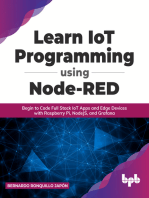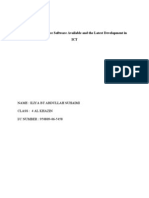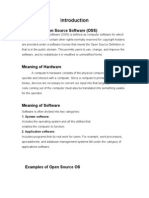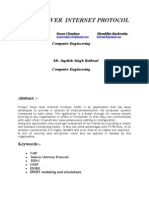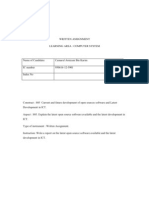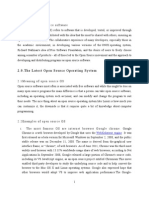ICT Assignment OS
ICT Assignment OS
Uploaded by
Kuganesh KandasamyCopyright:
Available Formats
ICT Assignment OS
ICT Assignment OS
Uploaded by
Kuganesh KandasamyOriginal Description:
Copyright
Available Formats
Share this document
Did you find this document useful?
Is this content inappropriate?
Copyright:
Available Formats
ICT Assignment OS
ICT Assignment OS
Uploaded by
Kuganesh KandasamyCopyright:
Available Formats
NAME: MAHESH A/l THAIALA RAO
CLASS: 4 SCIENCE 5
IC NUMBER: 950411-08-5221
Current and Future Development of Open Source Software and Latest Development in ICT
COMPUTER SYSTEM LATEST AND FUTURE DEVELOPMENT OF OPEN SOURCE SOFTWARE AND LATEST DEVELOPMENT IN ICT
1.0
INTRODUCTION
Meaning of open source software
Open source software is a software whose source code is published and made available to the public, enabling anyone to copy, modify and redistribute the source code without paying royalties or fees. Open source code evolves through community cooperation. These communities are composed of individual programmers as well as very large companies.
Meaning of software
Software is program which consists of a set of instruction that that tells the computer how to perform specific operation. It is general term to use to describe a collection of computer programs, procedures and documentations that perform task on a computer system. Software is often divided into application software and system software.
Meaning of hardware
Hardware refers to physical piece of computer .This could be a hard drive, monitor, memory chip or CPU. The key idea is that the item is something you can touch. Hardware implies permanence and invariability.
2.0
THE LATEST OPEN SOURCE OPERATING SYSTEM (OS)
2.1
Meaning of open source operating system
Open source refers to any program where source is made available for use. Operating system is the program that after being initially installed into the computer by a boot program, manages all the other program in the computer. Therefore, open source operating system mean a set of operating system that source code is available to manage or modify all the other program in the computer for users activities.
2.2
Example of open source operating system
Linux the latest Linux is updated on 26 January 2012. It is a freely distributed UNIX, it is a compatible operating system for PCs and a number of other processors. It provides a great deal of liberty to those that interact with Linux technology.
Ubuntu is a computer operating system based on the Debian Linux distribution and distributed as free and open source software. Ubuntu is designed primarily for use on personal computers, although a server edition also exists.
3.0
THE LATEST OPEN SOURCE APPLICATION SOFTWARE
3.1
Meaning of open source application software
Open source is used by the open source initiative to determine whether or not a software licence can considered open source. Application software mean all programs that perform specific tasks for users, which include word processing, spreadsheet, database, presentation e-Mail and Web browser software. So, open source application software mean open source initiative to determine the programs that perform specific tasks for users and the source code is available for download and anybody can modify it and release subsequent versions of the same provided version of the source using which they modified.
3.2
Example of open source application software
GNOME Office empowers you with three "best in class" productivity applications available as GNU Free Software. The times of wrestling with file formats, compatibility, and 'halfway-there' features is over. The AbiWord word processor, Gnumeric spreadsheet, and Gnome-DB data access components allow you to get it done now.
A free office suite of applications available for many different operating systems including Linux, Microsoft Windows, Solaris, OpenVMS, IRIX and Mac OS X. It supports the OpenDocument standard for data interchange. OpenOffice.org is based on StarOffice, an office suite developed by StarDivision and acquired by Sun Microsystems in August 1999. The source code of the suite was released in July 2000 with the aim of reducing the dominant market share of Microsoft Office by providing a free, open and highquality alternative. OpenOffice.org is free software, available under the GNU Lesser General Public License (LGPL).
4.0
LATEST DEVELOPMENT IN ICT 4.1 Hardware
4.2
Software (antivirus)
Differences of different antivirus Kaspersky Anti-Virus 2011 Preliminary Review
It's that time of year again: the new versions of antivirus software are already starting to come out. Kaspersky has recently released their latest antivirus software, Kaspersky Anti-Virus 2011. We're running a full test on this new antivirus software, and while we're not done yet, here are our preliminary findings to better inform you on your purchase. Kaspersky Anti-Virus 2011 has already received some of the major testing labs' stamps of approval; hopefully, we'll be able to do the same when our testing is complete. The user interface is toned-down and in some ways easier to use; the antivirus engine scored well in independent lab tests and seems to have good resource usage so far. New Features Desktop Security Gadget System Watcher Clean user interface Top Features Better resource usage Improved virtual keyboard Good virus detection
The only thing we're slightly concerned about thus far: a few false-positives during manual scanning. Otherwise, things are looking good for Kaspersky this year.
BitDefender Antivirus Pro 2011 Preliminary Review
Antivirus companies are coming out earlier and earlier with their new antivirus software versions each year.
And BitDefender has a new and improved antivirus software edition for you already: BitDefender Antivirus Pro 2011.
We're in the midst of our regular thorough testing of BitDefender Antivirus Pro 2011 which we're wrapping up and expect to have online for you very soon.
In the meantime, we wanted to share our initial findings with you to better inform you on your purchase. New Features Quick Scan cloud technology Custom dashboard Anti-phishing control Top Features Solid antivirus Chat encryption Good root-kit detection Our initial impressions with BitDefender Antivirus Pro 2011 are positive with only a few concerns. On the plus side, BitDefender keeps up their reputation with a thorough antivirus engine.
The new interface is customizable, professional, and easy to use. And the cloud-based Quick Scan
seems to be quite effective.
On the minus side, some of the initial testing shows BitDefender's results to fluctuate depending on the environment. It's too early to say how this will effect overall performance, so further testing is required.
Despite a couple of yellow flags, BitDefender Antivirus Pro 2011 looks like it's going to be a tough competitor for all new antivirus software versions coming out.
5.0
PERVASIVE COMPUTING
5.1 Meaning of Pervasive Computing
The idea that technology is moving beyond the personal computer to everyday devices with embedded technology and connectivity as computing devices become progressively smaller and more powerful. The goal of pervasive computing, which combines current network technologies with wireless computing, voice recognition, Internet capability and artificial intelligence, is to
create an environment where the connectivity of devices is embedded in such a way that the connectivity is unobtrusive and always available.
5.2 Example of Pervasive Computing 1) Personal Digital Assistant (PDA)
A personal digital assistant (PDA) is a handheld computer, also known as a palmtop computer. Newer PDAs also have both color screens and audio capabilities, enabling them to be used as mobile phones, web browsers, or portable media players. Many PDAs can access the Internet via Wi-Fi, or Wireless Wide-Area Networks (WWANs). Many PDAs employ touch screen technology. 1) 3G technology video phone
6.0
CONCLUSION
We can determine the meaning to computer software for which the source code and certain other rights normally reserved for copyright holders are provided under a software license that meets the open source definition that is in the public domain. Open source hardware is defined as, ways to collaborate in hardware development, as well as a model for sustainable development. Pervasive computing is the result of computer technology advancing at exponential speeds -- a trend toward all man-made and some natural products having
10
hardware and software. Pervasive computing goes beyond the realm of personal computers: it is the idea that almost any device, from clothing to tools to appliances to cars to homes to the human body to your coffee mug, can be imbedded with chips to connect the device to an infinite network of other devices. The goal of pervasive computing, which combines current network technologies with wireless computing, voice recognition, Internet capability and artificial intelligence, is to create an environment where the connectivity of devices is embedded in such a way that the connectivity is unobtrusive and always available.
Reference
http://en.wikipedia.org/wiki/ http://en.wikipedia.org/wiki/software http://en.wikipedia.org/wiki/microsoft_windows http://en.wikipedia.org/wiki/open_source_software http://www.answers.com/topic/software_technology http://wiki.answers.com/Q/Definition_open_source_application_software
11
http://www.pcantivirusreviews.com/antivirus-comparison-more.html http://downloadpedia.org/Open_Source_Operating_Systems
12
You might also like
- Abnormal Psychology 11th EditionDocument12 pagesAbnormal Psychology 11th Editionjigiwex146No ratings yet
- 09 April 2024 Vocabulary PDFDocument4 pages09 April 2024 Vocabulary PDFUday SainiNo ratings yet
- Frindle TestDocument2 pagesFrindle Testxtnsweetie100% (2)
- Lesson # 2 The Evolution of EnglishDocument11 pagesLesson # 2 The Evolution of EnglishMari Toni DestuaNo ratings yet
- Learn IoT Programming Using Node-RED: Begin to Code Full Stack IoT Apps and Edge Devices with Raspberry Pi, NodeJS, and GrafanaFrom EverandLearn IoT Programming Using Node-RED: Begin to Code Full Stack IoT Apps and Edge Devices with Raspberry Pi, NodeJS, and GrafanaNo ratings yet
- Perfectionism The Crucible of Giftedness-SILVERMANDocument24 pagesPerfectionism The Crucible of Giftedness-SILVERMANsupabobby100% (1)
- Book Line TextbooksDocument1 pageBook Line TextbooksYourBookLineNo ratings yet
- The Latest Open Source Software Available and The Latest Development in IctDocument9 pagesThe Latest Open Source Software Available and The Latest Development in IctColby DayNo ratings yet
- Ict Assignment 1Document11 pagesIct Assignment 1Iliya SuhaimiNo ratings yet
- FORM 4 ICT Written Assignment - The Latest Open Source Software and The Latest Development in ICTDocument10 pagesFORM 4 ICT Written Assignment - The Latest Open Source Software and The Latest Development in ICTCher Evaesca SayunNo ratings yet
- Open Source Software: Key AdvantagesDocument14 pagesOpen Source Software: Key AdvantagesTarun Kumar100% (1)
- IctassignmentDocument8 pagesIctassignmentAnonymous zCF2Ag1gMjNo ratings yet
- Meaning of Open Source Software (OSS)Document7 pagesMeaning of Open Source Software (OSS)Firazman RaykilsNo ratings yet
- Sekolah Menengah Kebangsaan Serdang, 09800, Serdang Kedah, Darul AmanDocument11 pagesSekolah Menengah Kebangsaan Serdang, 09800, Serdang Kedah, Darul Amanchinglove1314No ratings yet
- Assignment Complete)Document8 pagesAssignment Complete)Cheet Han LeeNo ratings yet
- The Latest Open Source Software Available and The Latest Development in ICTDocument7 pagesThe Latest Open Source Software Available and The Latest Development in ICTamncrewNo ratings yet
- The Latest Open Source SoftwareDocument9 pagesThe Latest Open Source SoftwareIzwan Ewan0% (1)
- Open Source SotwareDocument57 pagesOpen Source SotwareMohan KumarNo ratings yet
- S05 Loh Ka YangDocument10 pagesS05 Loh Ka YangRidzuan WrNo ratings yet
- The Latest Open Source Software Available and The Latest Development in ICTDocument7 pagesThe Latest Open Source Software Available and The Latest Development in ICTYap Shu QiNo ratings yet
- La2 With Content (ICT)Document10 pagesLa2 With Content (ICT)Brian FernandezNo ratings yet
- Hafiz Rodze - The Latest Open Source Software and The Latest Development in ICTDocument10 pagesHafiz Rodze - The Latest Open Source Software and The Latest Development in ICTChe Bashah SahakNo ratings yet
- Ict Brian Anish (5 Syukur) La2Document10 pagesIct Brian Anish (5 Syukur) La2Brian FernandezNo ratings yet
- Open Source Ict Assignment Form 4Document10 pagesOpen Source Ict Assignment Form 4Varsneya EruthayamNo ratings yet
- Name: Siddiq Bin HambaliDocument8 pagesName: Siddiq Bin HambaliSiddiq HambaliNo ratings yet
- The Latest OpenDocument12 pagesThe Latest OpenSabri RozalinNo ratings yet
- FOLIO T4 IctDocument9 pagesFOLIO T4 IctMizTa YaVin ZFNo ratings yet
- Ict ProjectDocument11 pagesIct ProjectZharfan SufianNo ratings yet
- SMK Sultan Salahudin Abdul Aziz ShahDocument7 pagesSMK Sultan Salahudin Abdul Aziz Shahhbk_rugby7109No ratings yet
- 10 IntroductionDocument7 pages10 IntroductionMohd Syafiq ZhafriNo ratings yet
- Sekolah Menengah Kebangsaan Tanjung Gemok Information and Communication Technology 3 7 6 5 / 2 Sijil Pelajaran Malaysia (2 0 1 2 / 2 0 1 3)Document10 pagesSekolah Menengah Kebangsaan Tanjung Gemok Information and Communication Technology 3 7 6 5 / 2 Sijil Pelajaran Malaysia (2 0 1 2 / 2 0 1 3)Suriaraj KrishnanNo ratings yet
- 2022 Ebook Industrial Open Source 1st EditionDocument165 pages2022 Ebook Industrial Open Source 1st EditionmiguinhoNo ratings yet
- Google's Android: Study Report With Other Mobile Operating SystemDocument19 pagesGoogle's Android: Study Report With Other Mobile Operating SystemPrasanna DhanasekaranNo ratings yet
- Conceptual Framework: Review of Related Literature and StudiesDocument47 pagesConceptual Framework: Review of Related Literature and Studiesapi-26570979No ratings yet
- Kerja Kursus Open SourceDocument6 pagesKerja Kursus Open SourceAlif DskNo ratings yet
- Open Source AssingmentDocument9 pagesOpen Source Assingmenthidayat-has-3683No ratings yet
- C6 Presentation Economic Information SystemsDocument18 pagesC6 Presentation Economic Information SystemsIon BuligiuNo ratings yet
- Title: The Latest Open Source Software Available and The Latest Development in IctDocument18 pagesTitle: The Latest Open Source Software Available and The Latest Development in IctILa SuhaiLaNo ratings yet
- Operating System Assignment#1Document14 pagesOperating System Assignment#1Ramsha MalikNo ratings yet
- Open Source - Kerja Kursus Ict (Lengkap&terbaru)Document10 pagesOpen Source - Kerja Kursus Ict (Lengkap&terbaru)Salahuddin Ahmad85% (13)
- SMK Sulaiman, BENTONG 28700.: Current and Future Development of Open Source Software and Latest Development IN ICT (2013)Document15 pagesSMK Sulaiman, BENTONG 28700.: Current and Future Development of Open Source Software and Latest Development IN ICT (2013)HariBoy NotSo FreeTodayNo ratings yet
- Syahir Punyalah!!Document9 pagesSyahir Punyalah!!syahir1994No ratings yet
- Nama: Muhd Lukeman Haqeem Bin Firdaous Kelas: 5ST1 Guru: Puan FeateyDocument12 pagesNama: Muhd Lukeman Haqeem Bin Firdaous Kelas: 5ST1 Guru: Puan FeateyNurhayati binti Abu BakarNo ratings yet
- IntroductionDocument4 pagesIntroductionLolzSword HmcaNo ratings yet
- WRITTEN ASSIGNMENT - Latest Open Source Software Available and The Latest Development in ICTDocument12 pagesWRITTEN ASSIGNMENT - Latest Open Source Software Available and The Latest Development in ICTSYarafina SYed91% (11)
- Meaning of Operating System and The ExamplesDocument4 pagesMeaning of Operating System and The Examplesنبيلة عطيرةNo ratings yet
- Concept of Hardware and Software Capabilities and Limitations of Computers Data Processing Cycle Intro To Internet and EmailingDocument18 pagesConcept of Hardware and Software Capabilities and Limitations of Computers Data Processing Cycle Intro To Internet and EmailingEtta Fe AlcaldeNo ratings yet
- Voice Over Internet Protocol: Computer EngineeringDocument6 pagesVoice Over Internet Protocol: Computer EngineeringsandeepNo ratings yet
- Tle-Ict Computer Systems Servicing Quarter 3 - Module 1Document10 pagesTle-Ict Computer Systems Servicing Quarter 3 - Module 1Charisma Bless Sabado Dolor100% (1)
- SMK Bukit Saujana Title: The Latest Open Source Software Available and The Latest Development in IctDocument13 pagesSMK Bukit Saujana Title: The Latest Open Source Software Available and The Latest Development in IctMuhammad Shafiq KoRnNo ratings yet
- Current and Future Development of Open Source Software and Latest Development in IctDocument10 pagesCurrent and Future Development of Open Source Software and Latest Development in IctNur SyamimieNo ratings yet
- 2.1) Meaning of Open Source OSDocument8 pages2.1) Meaning of Open Source OSMusdalipah SalamatNo ratings yet
- Kerja Kursus ICTDocument11 pagesKerja Kursus ICTMuhammad KiraNo ratings yet
- Imgburn: Freeware SoftwareDocument6 pagesImgburn: Freeware SoftwareTAYYBA SHAHIDNo ratings yet
- The Latest Open Source Software AvailableDocument11 pagesThe Latest Open Source Software AvailableAzilah UsmanNo ratings yet
- E VotingDocument51 pagesE VotingRadha Devi PeriyasamyNo ratings yet
- Operating System (O.S)Document17 pagesOperating System (O.S)Amirul Zack100% (1)
- Webkit Layout EngineDocument9 pagesWebkit Layout EngineAvinesh NeshNo ratings yet
- ICT AssignmentDocument5 pagesICT AssignmentFaiDa ArNielNo ratings yet
- Application SoftwareDocument6 pagesApplication Softwareessum belaNo ratings yet
- Information Communication Technology: The Latest Open Source Software Available and The Latest Development in IctDocument10 pagesInformation Communication Technology: The Latest Open Source Software Available and The Latest Development in IctLim SuyingNo ratings yet
- Software Suite: Revolutionizing Computer Vision with the Ultimate Software SuiteFrom EverandSoftware Suite: Revolutionizing Computer Vision with the Ultimate Software SuiteNo ratings yet
- Linux: A complete guide to Linux command line for beginners, and how to get started with the Linux operating system!From EverandLinux: A complete guide to Linux command line for beginners, and how to get started with the Linux operating system!No ratings yet
- Android Programming For Beginners: The Ultimate Android App Developer's GuideFrom EverandAndroid Programming For Beginners: The Ultimate Android App Developer's GuideNo ratings yet
- Alexandra June Peterson: EducationDocument1 pageAlexandra June Peterson: Educationapi-428816053No ratings yet
- DATA SCIENCE COURSE Python Programming CourseDocument3 pagesDATA SCIENCE COURSE Python Programming Coursemohammed KhalidNo ratings yet
- List of Qs Here Are 50 Questions For ESL A2 LearnersDocument2 pagesList of Qs Here Are 50 Questions For ESL A2 LearnersValeria ReyesNo ratings yet
- Evaluating Messages or Images (E.g Pictures, Illustrations of Different Types of TextsDocument18 pagesEvaluating Messages or Images (E.g Pictures, Illustrations of Different Types of TextsMarie TiffanyNo ratings yet
- Grammar WritingDocument128 pagesGrammar WritingKirti Bhushan Kapil100% (3)
- Department of EnergyDocument4 pagesDepartment of EnergyDaisuke Inoue100% (3)
- Workplace Expectations of Genz Towards Factors of MotivationDocument13 pagesWorkplace Expectations of Genz Towards Factors of MotivationД' ДөлгөөнNo ratings yet
- Krister Ann Jimenez ACTIVITY 14 ParagraphDocument17 pagesKrister Ann Jimenez ACTIVITY 14 ParagraphJamie JimenezNo ratings yet
- Park Psych Science 2007Document5 pagesPark Psych Science 2007Nur AdekunleNo ratings yet
- Checklist For IDEA Lesson ExemplarDocument2 pagesChecklist For IDEA Lesson ExemplarEmerson Nunez100% (1)
- 10th Radiology Residents HOT SEAT Review CourseDocument8 pages10th Radiology Residents HOT SEAT Review CourseLajja Parikh PatelNo ratings yet
- Apprenticeship ContractDocument5 pagesApprenticeship ContractZoe MoralesNo ratings yet
- CoherenceDocument18 pagesCoherenceNada NasserNo ratings yet
- N Gen Math 6.unit 11.lesson 1.statistical Questions 1Document4 pagesN Gen Math 6.unit 11.lesson 1.statistical Questions 1satwithalexNo ratings yet
- Factor of Being Late Students in General Mariano Alvarez Technical High SchoolDocument5 pagesFactor of Being Late Students in General Mariano Alvarez Technical High SchoolKennedy BalmoriNo ratings yet
- AttitudesDocument18 pagesAttitudesthisn1ggatrippingNo ratings yet
- Psychology Unit 3Document9 pagesPsychology Unit 3Nancy MohamedNo ratings yet
- The Gift of Loneliness - Alice Walkers - em - The Color Purple - emDocument6 pagesThe Gift of Loneliness - Alice Walkers - em - The Color Purple - emPriyaNo ratings yet
- Azzam TizapurDocument2 pagesAzzam TizapurKavitha KrishnanNo ratings yet
- 4 Rainbows and DiffractionDocument5 pages4 Rainbows and DiffractionrebbiegNo ratings yet
- Steps To A Basic EssayDocument2 pagesSteps To A Basic EssayRatul HasanNo ratings yet
- Your Nobel Dream, GSLC of EeseDocument2 pagesYour Nobel Dream, GSLC of EeseIvan SitanayaNo ratings yet
- Greendale Secondary End of Year 2018 Sec 3 A MathDocument16 pagesGreendale Secondary End of Year 2018 Sec 3 A Mathtathira46No ratings yet
- Detailed Lesson Plan in Health 2Document9 pagesDetailed Lesson Plan in Health 2Carmela Aduca100% (5)




